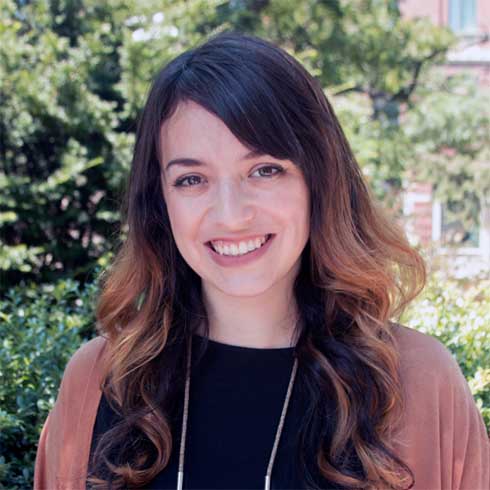Sound Stories: Why audio journalism works
"Good audio stories... worm their way into our brain with specificity and emotion."
So said Nadia Reiman — a supervising producer for the award-winning This American Life weekly radio show and podcast — in a talk at Nazareth College that included examples of using audio strategically and creatively.
You know when you overhear one side of an argument involving a person on a cell phone, and you can't stop listening? That half-a-conversation sound leaves gaps that your brain wants to fill in. Good audio must "lay out a mystery for your brain to unfold," said Reiman.
She got hooked on auditory storytelling as a child, hearing bedtime stories read aloud by her mother, who used different voices for each of the three little pigs and other characters. "They came to life through sound," Reiman recalled.
Now the journalist reports and tells in-depth stories — such as a 25-minute immigration piece titled Save the Girl about a young woman named Yong, 19, from Laos. Yong had a visa and papers to come to the United States as a fiance. To immigration workers, she looked young and was suspected of being a victim of sex trafficking — which led to them holding her in shelters for 13 months. Along the way, her birthdate was falsely written to make it seem she was 17 or 15 — and she was forced to attend high school. Reiman says she likes complicated, unexpected stories: "I like when there's not a clear bad guy."
Reiman, who immigrated herself to the United States from Costa Rica on a visa and has become a naturalized citizen, pointed out that the perspectives of people of color are important to hear to know the full story. She previously worked at StoryCorps, where she and teammates won a Peabody Award for their 9/11 coverage. Reiman was the senior editor at NPR's Latino USA, where her work received the National Association of Hispanic Journalists Ñ Award, among others.
Her visit was part of a series of events at Nazareth during Latinx Heritage Month, honoring the histories, cultures, and contributions of people of Latin American and Spanish descent.
Reiman's advice for anyone who wants to be a great storyteller:
"Get a really good editor. Don't be afraid to have your work torn apart. They are invaluable." That's how you learn.
Take risks — and try again.
Listen to a lot of media. You'll get ideas. When you find something you really like, listen over and over and analyze what makes it work.
And copy. If you really love RadioLab, try to make something like that.
Contact
Julie Long | Chief PR Officer | 585-389-2456 or jlong2@naz.edu
Nazareth University is an inclusive community of inspired learners, educators, and changemakers who for 100 years have been driven by a bold commitment to action, empathy, equity, and leading innovation for the common good. Impact experiences are at the heart of a Nazareth education, preparing each student to discover within themselves the potential to cultivate positive change in their life's work, in any career field, and in a world that is constantly evolving and infinitely interconnected.
Our broad academic offerings present a range of study options typical of larger universities, yet achieved in our supportive campus culture. Nearly 2,100 undergrad and 600 graduate students enroll in degree and certificate programs and engage in collaborative, transformative learning experiences, preparing for the professions and society of today and tomorrow. In a learning community that purposefully integrates liberal arts and professional programs, Nazareth University graduates are able to launch a lifetime of impactful leadership in communities and workplaces near and far.

Nadia Reiman — a supervising producer for the award-winning This American Life weekly radio show and podcast — in a talk at Nazareth College that included examples of using audio strategically and creatively.